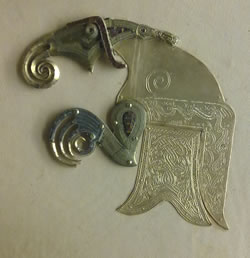

The story of the Þunorrad begins, as not enough stories do, on a hill in Northamptonshire.
Several years ago, a small group made their separate ways from across Mercia, to stand on that high earth under a sky that stretched as far as could be seen. Witnessed by all present, both seen and unseen, they announced their place in the world.
In time, they spoke. First, to acknowledge old gods. Second, to remember ancestors. Third, to tell of deeds to come. Their words, sealed with drink, became the binding of them, and they came down the hill a folc.
They came to be known as the Þunorrad.
The folk of the Thunorrad (or Þunorrad folc - pronounced thoo-nor-rad folk) are committed to exploring and developing an understanding of English folklore specific to the land around them, namely, the modern day English Midlands. This understanding has been used to establish social and ritualistic practices that serve to connect us to our communities, our past, and the land around us, perhaps in ways not too dissimilar from those consistent throughout English history (or even earlier).
This translates to a structured ritual year where fertility rites and other cultic behaviour is observed, as well as feasting, and engaging with established local folk traditions that are already in keeping with the Þunorradisc worldview.
When behaviour or belief is given to and retained by another, it becomes a tradition. Tradition is seen in all human societies across the world, ranging from the newly established, to those older than history can tell. Whether remaining consist ant, or changing over time, many of these traditions contain great significance, underpinning cultures on all levels and playing a part in many aspects of both public and private life. Their expression can be found in forms such as myth, poetry, art and ritual, both in religious and non religious spheres. At their most functional, these expressions often serve to reflect and reinforce an ordering of reality; an orientation for a person and their community within the world - a worldview.
Up until relatively recently, European peoples largely held on to their folk traditions. With shared roots in pastoral cultures, there are many similarities between them. That being said, culture is constantly subject to change, and so there also exist unique traditions, sometimes kept by only a small number of people in a small region.
With the wide ranging impacts of science, industrialisation and technology, and an ever globalising world, European societies have changed dramatically, with many traditions no longer being handed down, with their meanings becoming obscured or forgotten. An increasingly urbanised population are removed from the agriculturally based traditions of the past, while mobile, highly individualised lifestyles, risk ending communal traditions entirely.
In spite of this, people still display the desire to engage with their folk tradition, whether that be by forming new traditions faithful to the past, or by resurrecting old ones as best able. Realising the meanings of such tradition and passing them on to others is an endeavour that the Þunorrad folc have chosen to participate in. Judging by the results, it can confidently be asserted that old traditions continue to have significance, even today.
All traditions have a proper time and place, and it is no accident that across Europe, similar traditions happen at similar times. Their roots lie in the community's needs, and their timings are set the natural order of seasons, and the lunar and solar cycles.
For the Þunorrad, the reckoning of the ritual year has been developed from the writing of the Venerable Bede and the Old English month names. The year is split into summer and winter, with the transitions from one to the other marked with appropriate ritual acts, both indoors and outdoors. Other times of the year which have traditionally been important to agriculture (such as harvests) and community (such as mid-winter), are also celebrated in ways consistent with the folk traditions of England and the worldview of the Þunorrad folc.
The Þunorrad folc have a Merican bias, with folk currently living in the counties of Gloucestershire, Warwickshire, Leicestershire and Northamptonshire.

Shield mount from Sutton Hoo potentially depicting
Woden in eagle form, note the garnet human head on the hip.
All imagery and text on this web site is copyright to members of the Þunorrad ©2014